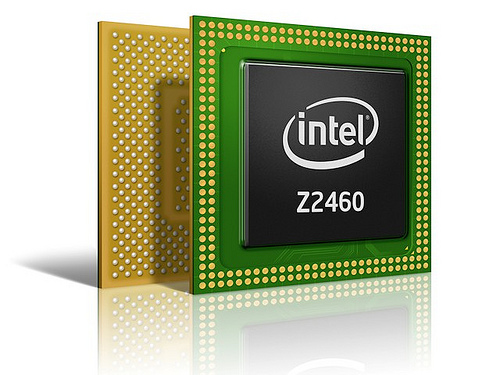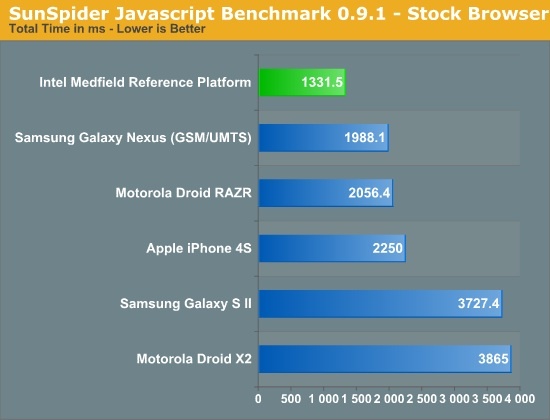Intel Medfield Platform. Atom Z2460 processor for smartphones

I'd like to start the post with the phrase "Intel unleashed the Atomic War." But I will not, because Intel is not at war with anyone. The company just entered the smartphone market.
See the details under the cut.
Reference design.
At CES 2012, Intel introduced the reference design of a smartphone with a processor based on the Medfield platform.

')
The screen of the device is 4.03 "in size with a resolution of 1024x600. A camera with a resolution of 8 megapixels allows you to shoot Full-HD video and a 1.3 megapixel camera on the front side to make video calls. In addition to the usual microUSB, the device is equipped with an HDMI port.
At the recent Mobile World Congress 2012 several models were presented based on the reference design of Intel:
Performance.
Those who managed to hold the smartphone in their hands claim that it works very quickly. I will give one of the tests:

In the browser test of Javascript execution, the new Atom for smartphones leaves the competition on ARM processors far behind.
CPU.
The Atom Z2460 processor is manufactured using 32nm technology and operates at 1.6 GHz. It contains an integrated dual-channel LPDDR2 400MHz memory controller, up to 1GB.
Also integrated into the chip is a graphics accelerator Intel GMA and a signal processor for image processing.
The first provides hardware acceleration in three-dimensional applications and HD video playback, and the second - fast image capture in low light conditions.
At the same time, the new Atom is able to compete with processors on the ARM architecture for power consumption. Smartphones with this processor can work for several days on a single charge (details below).
Despite the fact that physically the processor has only one core, due to the technology of Hyper-Threading, it can process two streams of instructions in parallel. In this case, an increase in productivity of 30-40%
The integrated graphics accelerator Intel GMA is essentially licensed to Imagination Technologies by the PowerVR SGX540 core. It works at a frequency of 400 MHz, supports OpenGL ES2.0 and OpenVG 1.1. Also provides hardware support for encoding and decoding of HD video (MPEG4.2, H.264).
A signal processor for image processing provides bandwidth up to 240 Megapixels per second (mpps). This bandwidth allows continuous shooting of 10 frames at a speed of 15 frames per second and provides exceptional image quality.
Intel Smart Idle (Intel SIT) technology allows you to turn off most of the processor units, while the operating system is idle and instantly returns the system to active mode.
The processor supports two display interfaces. Each screen can have a resolution of up to 1024x768. Also on the chip is implemented interface HDMI 1.3a, with which the device can be connected to a Full-HD TV.
PoP packaging.
The Atom Z2460 core is packaged in a BGA package with a size of just 12x12mm, 0.4mm thick, and contains 617 pins. The most interesting thing is the technology Package-on-Package (PoP), which allows you to install a memory module directly above the processor, saving space on the printed circuit board.
In a section it looks like this:

Smartphone power consumption (at identical screen brightness) according to Intel and Anandtech tests given here ,
| Inaction (3G) | Conversation (3G) | Internet surfing (3G) | 720p video playback | |
| Apple iPhone 4S | ~ 38mW | ~ 800mW | ~ 1.3W | ~ 500mW |
| Reference Intel Medfield | ~ 18mW | ~ 700mW | ~ 1.0W | ~ 850mW |
| Samsung Galaxy S II | ~ 19mW | ~ 675mW | ~ 1.2W | ~ 650mW |
The prototype, equipped with a standard battery 1,460mAh in tests (voiced by Intel at CES 2012), showed the following results:
- 5 hours with internet surfing over 3G
- 6 hours when watching 1080p video
- 45 hours of music playback
- 14 days in sleep mode.
These results show the ability of the new platform to compete with the best smartphones on the market.
Conclusion
In conclusion, I would like to share my thoughts on what new opportunities the x86 architecture can give in the smartphone market.
Surely, many have heard of Motorola's WebTop technology. In a nutshell, devices that support this technology can be connected through a docking station to a Full-HD TV or monitor and peripheral devices. The smartphone runs a full-fledged operating system based on Ubuntu. On Habré you can read about it here . I happened to try it myself on the Motorola Photon smartphone, and the idea is undoubtedly very good. Unfortunately, the performance of even the fastest ARM processors is not enough for comfortable work with the desktop operating system. After all, for many years, Linux was optimized primarily for the x86 platform. With the advent of Atom processors for smartphones, such technologies can get a second wind.
Source: https://habr.com/ru/post/139527/
All Articles